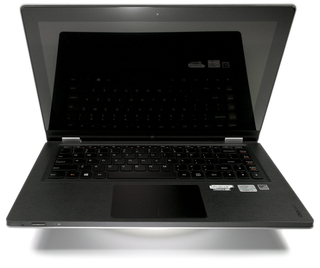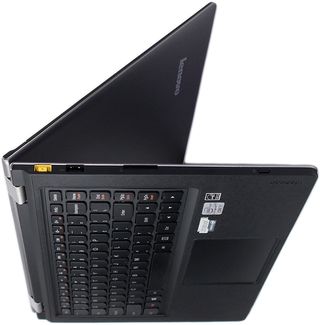Lenovo IdeaPad Yoga 13 Review: One Flexible Ultrabook
Whether in notebook, stand, tent, or tablet mode, the Lenovo IdeaPad Yoga 13 is definitely a head-turner. But does this Ultrabook's innovative multi-mode design effectively juggle its multiple personalities in an equally-harmonious, Zen-like manner?
Not Perfect, But Still A Great Value

Our time with the Lenovo IdeaPad Yoga 13 was very Zen-like in the beginning, filled with ego-boosting moments of showing off our flexible trophy to all who would bear witness. As the novelty waned and our teardown commenced, we focused more on what lies below the system’s impressive exterior. We couldn’t help but second-guess our initial excitement. Did we fall too hard for the Yoga 13’s beautiful aesthetics, or does its flexibility make up for the performance hit attributable to the lost memory channel?

On the upside, Lenovo’s IdeaPad Yoga 13 is surely thin and lightweight. The satin-finished aluminum system casing is both solid and elegant. The island-style keyboard is above average, the massive touchpad is great, and the IPS-based touchscreen is fantastic. The innovative hinges are sturdy enough to accommodate all four of the Yoga 13’s usage modes, making this one truly versatile mobile PC. It runs cool and quiet, and the performance is more or less what we’d expect to see for a system with these specifications.

An empty mSATA/min-PCIe port in this form factor are just icing on the cake, right? Unfortunately, since the Yoga 13 isn’t openly user-serviceable, getting to these components isn’t a job for the timid. And while upgradable memory may seem like a bonus since most models in this size class feature RAM soldered directly to the motherboard, due to the Yoga 13’s closed nature, this also loses much of its relevance.

While we’re on the subject of the Yoga 13’s memory, Lenovo sacrificed part of this system’s full potential for that removable RAM. In order to allow for upgradable memory, it seems that the company only had room for a single module, locking the Yoga 13 into single-channel memory mode. SATA transfer speeds and general CPU performance also appear to be slightly lower than Dell's competing XPS 12 in our synthetics. However, since the real-world benchmarks don’t show any significant performance drop compared that other slim Ultrabook, we'll let you decide whether the Yoga 13’s removable memory is a pro or a con.

The non-standard internal WLAN card also limits the upgrade path of that component. Speaking of upgrades, we’re not happy that the Yoga 13 can't be ordered with a backlit keyboard, seeing as most Ultrabooks in this price class have this at least as an option. For that matter, the exposed keyboard in the Stand, and especially in Tablet Mode, is something that we doubt we’ll ever be fully comfortable with.
All of that aside, with a starting price of $1,000, the Lenovo IdeaPad Yoga 13 still presents a solid value for a high-end Ultrabook. And even with its shortcomings, there's no denying that the foundation exists for the Yoga 13 to be a well-rounded solution for today’s multi-tasking, multi-device user.

If Lenovo had included a second bank of removable memory and a backlit keyboard, we'd have no technical qualms with the design. As it stands, the Yoga family has a viable future, and we definitely look forward to seeing what Lenovo has up its sleeves now that Haswell-based processors are available. Thinner, lighter, and more battery life, anyone?
Stay on the Cutting Edge
Join the experts who read Tom's Hardware for the inside track on enthusiast PC tech news — and have for over 25 years. We'll send breaking news and in-depth reviews of CPUs, GPUs, AI, maker hardware and more straight to your inbox.
Current page: Not Perfect, But Still A Great Value
Prev Page Color, Viewing Angles, And Monitor Rating-
danaistina I bought a yoga 13 a few months ago. Author of the article obviously has some special version of this ultrabook, which no one else, including me and the people of the Lenovo forums has heard that there is no following problems: touchpad does not support all Windovs 8 gestures, wirerless card has very weak signal, runs very hot and noise from the vents is loud. And finally: windows 8 has not yet up to use touch screen like a android or ios devices.Reply -
danaistina I bought a yoga 13 a few months ago. Author of the article obviously has some special version of this ultrabook, which no one else, including me and the people of the Lenovo forums has heard that there is no following problems: touchpad does not support all Windovs 8 gestures, wirerless card has very weak signal, runs very hot and noise from the vents is loud. And finally: windows 8 has not yet up to use touch screen like a android or ios devices.Reply -
sgadadish Tent (Joke) Mode : simply serving as a digital picture frame placed tastefully on a shelf or desk . , Sure...Reply -
hothfox I contemplated this and the Thinkpad Twist, and wound up getting the Twist, largely because when you flip it around to it's tablet mode, the keyboard and touchpad are covered by the screen, instead of exposed.Reply -
Amdlova 9hr battery... idle and screen of... 5 hr real condition... when we get something can do 12 hrs.Reply -
whyso How is the yoga gettng better bandwidth numbers that it is in theory capable of? 21GB/sec for cached read when theoretically it maxes out at 12.8 GB/secReply -
Kattie Anderson Get a premium support for yoga at http://ytechsupport.com/lenovo-laptop-support-.htmlReply
Most Popular

